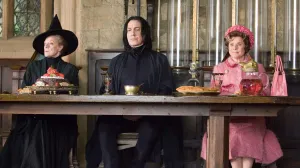An effective opening credits sequence is a crucial element of television, serving as a calling card that sets the tone for the entire series. When done well, these brief introductions can tell viewers everything they need to know about a show in just a few moments. A great opening grabs the audience’s attention, establishes the genre and mood, and often becomes as iconic as the characters themselves. Plus, when it comes to horror television, a memorable title sequence has the power to unsettle and intrigue, weaving itself into the fabric of pop culture and creating lasting anxieties for viewers.
Videos by ComicBook.com
From the earliest days of television to the current era of streaming, horror and fantasy shows have utilized their opening credits to build immediate tension and dread, using a combination of haunting music, evocative imagery, and clever editing to create a lasting impression. Whether it is through a surreal animated journey, a montage of unsettling footage, or a simple yet unnerving melody, the best horror openings are unforgettable. Here’s our pick for the 10 most iconic opening credits from horror TV shows.
10) Black Mirror
Charlie Brooker’s Black Mirror first debuted in 2011 and quickly established itself as a successor to classic anthology shows like The Twilight Zone for the digital age. The British series examines the darker side of technology, with each standalone episode presenting a near-future scenario twisted by a single innovation. These stories explore how concepts like advanced AI, virtual reality, and invasive social media can erode human connection and lead to often bleak conclusions, functioning as modern cautionary tales about the tools we use every day.
Black Mirror‘s opening credits reflect this minimalist ethos. The sequence is brutally simple, as a humming electronic tone builds tension against a black screen before the show’s title appears and fractures with a sharp crack. This jarring effect serves a distinct purpose, acting as a disruptive jolt that pulls the viewer’s attention directly to the screen. The series’ title itself refers to the dark reflective surfaces of our devices, and the shattering visual symbolizes the breakdown of society or the individual psyche, a central theme in nearly every episode. As a result, the intro of Black Mirror is a concise piece of branding that prepares the audience for the unsettling experience to come.
9) Goosebumps
The 1995 series Goosebumps was a live-action children’s horror anthology that adapted R.L. Stine’s wildly popular book series for television. For many kids growing up in the 90s, the show served as a primary introduction to the horror genre, bringing iconic stories like The Haunted Mask and Night of the Living Dummy to life. Each week, it delivered tales of suburban kids encountering supernatural threats, from cursed objects to monstrous creatures, all while maintaining a tone that was spooky enough to be thrilling but safe enough for its young audience.
The opening credits sequence captures this spirit perfectly. It begins with a shadowy figure, implied to be Stine, whose briefcase unleashes a torrent of paper that carries the show’s “G” logo through a town, triggering strange events. The visuals were startling for a children’s program, featuring memorable images like a dog with glowing yellow eyes and a woman’s face warping into a monstrous visage. In addition, the theme music by Jack Lenz, with its distinctive piano melody and integrated dog barks, became instantly recognizable, signaling that you were about to watch something scary and fun.
8) Dexter
Premiering in 2006, Dexter is a crime drama that centers on a uniquely conflicted protagonist. The series follows Dexter Morgan (Michael C. Hall), a blood-spatter analyst for the Miami Metro Police Department who lives a secret life as a vigilante serial killer. Guided by a moral “Code” instilled by his adoptive father, Dexter channels his homicidal urges by hunting down and killing murderers who have evaded the justice system. The show’s core tension comes from this duality, exploring the life of a man pretending to be normal while hiding his monstrous nature in plain sight.
The Emmy-winning opening credits of Dexter brilliantly visualize this internal conflict by transforming a mundane morning routine into a sequence of violent acts. Through extreme close-ups and heightened sound design, the slicing of a blood orange appears brutal, frying ham sizzles like flesh, and flossing teeth looks unnervingly like a killer getting ready to strangle a victim. This macabre imagery is set against a deceptively upbeat and quirky musical score. This juxtaposition of the gruesome and the cheerful perfectly encapsulates Dexter’s character, creating a high-concept title sequence that is both clever and deeply unsettling.
7) Buffy the Vampire Slayer
Joss Whedon’s Buffy the Vampire Slayer, which premiered in 1997, became a cultural touchstone by blending supernatural horror with teen drama and witty dialogue. The series follows Buffy Summers (Sarah Michelle Gellar), a young woman chosen by fate to be a “Slayer” who battles demons and other dark forces in the fictional town of Sunnydale, California. The show was groundbreaking for its use of supernatural threats as metaphors for real-life adolescent anxieties, from high school bullies to heartbreak, becoming a cult classic that’s still relevant decades later.
The opening credits of Buffy the Vampire Slayer immediately establish the show’s genre-bending approach. The sequence begins with the sound of a lone organ, a classic horror trope that is quickly hijacked by an energetic pop-punk guitar riff from the band Nerf Herder. This musical shift signals the show’s subversive nature, rejecting traditional horror in favor of something modern and rebellious. The visuals are a fast-paced montage of action clips, showcasing Buffy’s impressive fighting skills alongside moments of friendship and romance. It functions as a high-energy promise of the action, humor, and horror to come.
6) The Munsters
First airing in 1964, The Munsters was a sitcom that satirized both American suburban life and the classic Universal monster movies. The series centered on a family of lovable monsters, including a Frankenstein-like father named Herman (Fred Gwynne), his vampiric wife Lily (Yvonne De Carlo), and their grandfather (Al Lewis), a version of Count Dracula. The show’s comedy was derived from the family’s attempts to live a normal American life, completely unaware that their neighbors found them terrifying.
The opening credits introduce this premise with a memorable surf-rock theme composed by Jack Marshall. The music is an upbeat and instantly recognizable instrumental that sets a lighthearted tone. The visuals introduce each family member through title cards and visual gags that highlight their monstrous trait in a funny way, such as Herman’s hulking figure leaving home from a passage under the stairwell, or Grandpa trying to bite Lily’s wrists. This character-focused introduction perfectly communicated the show’s blend of sitcom antics and classic monster imagery, and the theme song itself became a cultural staple.
5) The Addams Family
Based on the single-panel cartoons by Charles Addams, The Addams Family premiered in 1964 as a satirical inversion of the ideal American household. The series followed a wealthy and eccentric clan who delighted in the macabre and were blissfully unaware that the rest of the world found them strange and frightening. Their home was filled with bizarre artifacts, and their interactions were defined by a dark yet wholesome affection for one another, creating a comedy that was both gothic and charming.
The show’s iconic opening credits are defined by Vic Mizzy’s unforgettable theme song. The tune, with its catchy melody and Mizzy’s own vocals, explicitly describes the family as “creepy and kooky, mysterious and spooky.” The most enduring element is the synchronized finger-snapping, a simple, interactive gimmick that made the intro a participatory event for viewers. The combination of the memorable song and the physical gesture has cemented its place in pop culture, making it one of the most famous and widely parodied TV themes of all time.
4) Alfred Hitchcock Presents
Beginning its run in 1955, Alfred Hitchcock Presents was a weekly anthology series that brought suspenseful tales to television under the guidance of its legendary host. Alfred Hitchcock, already a world-famous film director, served as the face of the show, introducing and concluding each episode with his signature brand of morbid humor. The stories themselves were often twist-filled crime dramas or psychological thrillers that reflected the director’s unique cinematic sensibilities.
The opening sequence of Alfred Hitchcock Presents begins with the whimsical “Funeral March of a Marionette” by Charles Gounod, a piece of music that has become synonymous with Hitchcock himself. As the tune plays, a simple line drawing of Hitchcock’s silhouette appears. The real Hitchcock then walks into frame, neatly fitting into the outline before turning to deliver his deadpan monologue. This simple but brilliant introduction made the host the star and established a personal connection with the audience that was unique for its time, setting a template that many other shows would follow.
3) Tales from the Crypt
Debuting on HBO in 1989, Tales from the Crypt was a horror anthology series based on the ghoulish EC Comics of the 1950s. Free from the constraints of network television, the show was able to fully embrace its source material’s graphic violence, dark humor, and twisted morality plays. Each episode was introduced by the Crypt Keeper (voiced by John Kassir), a cackling rotting corpse who delivered a barrage of horror-themed puns before presenting a story that usually ended with a villain getting a gruesome and ironic comeuppance.
The show’s opening credits are brilliant. The sequence takes the viewer on a first-person journey through a dilapidated mansion, down a winding staircase, and into the titular crypt below, all set to Danny Elfman’s carnivalesque and spooky theme music. The ride culminates with the Crypt Keeper bursting out of his coffin with a maniacal laugh. This highly produced, effects-heavy intro was a landmark for television, perfectly setting the stage for the unrestricted mayhem and gallows humor that made the series a fan favorite.
2) The X-Files
Chris Carter’s The X-Files, which first aired in 1993, defined a generation’s interest in the paranormal and government conspiracies. The series followed FBI agents Fox Mulder (David Duchovny) and Dana Scully (Gillian Anderson) as they investigated unsolved cases involving unexplained phenomena, from alien abductions to cryptids and psionic abilities. The show’s overarching mythology and “monster-of-the-week” format created a unique blend of serialized storytelling and procedural drama that captivated audiences throughout the 90s.
The iconic opening credits of The X-Files captured this atmosphere of mystery and paranoia. The sequence is a montage of grainy, low-fidelity images depicting UFOs, distorted figures, and other strange phenomena, making it feel like a piece of classified evidence. This is set to Mark Snow’s haunting instrumental theme. The whistle-like synth melody, enhanced with a distinct echo effect, became a cultural shorthand for anything strange or unexplained. The combination of the unnerving visuals and the unforgettable music created one of the most effective and recognizable title sequences in television history.
1) The Twilight Zone
Rod Serling’s anthology series The Twilight Zone premiered in 1959 and remains the benchmark for televised science fiction, horror, and fantasy. Each week, the show presented a standalone story that used genre concepts to explore the human condition, morality, and society’s anxieties. Serling served as the show’s creator, primary writer, and on-screen narrator, guiding viewers through tales that were often ironic, thought-provoking, and deeply unsettling.
The Twilight Zone’s most famous opening sequence is a definitive piece of television history. It features a montage of surreal, disorienting black-and-white images, paired with Marius Constant’s iconic and dissonant four-note guitar theme, a sound that instantly signals a journey into the strange. The sequence is anchored by Serling’s commanding narration, which invites the viewer into “a dimension of imagination… a middle ground between light and shadow.” The combination of these elements created a powerful, abstract, and unforgettable introduction to a world of limitless possibility.
What is your favorite horror TV show opening? Let us know in the comments!









